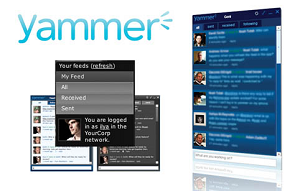Though the enterprise social networking company Yammer is not as popular as Facebook and Twitter, it is hard to ignore among graduate students. Yammer has more than 3 million users, which includes employees at more than 80 percent of Fortune 500 companies, and is accounting to $57 million in financing.
According to CEO David Sacks, 1,692 of the more than 100,000 organizations that use Yammer are in the educational industry. Sacks assess the overwhelming majority of this educational group belongs to colleges and universities since organizations form Yammer networks in common E-mail domains and high schools hardly ever issue E-mail addresses to students.
Since it got founded in 2008, Yammer has been immovable that its networks stay closed. Only those people with an osu.edu E-mail address can open the Ohio State University network, for example, similar to how Facebook functioned before it makes its registration available to the general public.
 Not only did Yammer differentiate itself from Facebook, but its internal and common nature has helped transform classroom education, according to Todd Watkins, assistant dean for dental education and informatics at East Carolina University’s School of Dental Medicine.
Not only did Yammer differentiate itself from Facebook, but its internal and common nature has helped transform classroom education, according to Todd Watkins, assistant dean for dental education and informatics at East Carolina University’s School of Dental Medicine.
Watkins think that Yammer is exceptional since it lets in expanding problem-based learning (PBL) opportunities, where students look up responses to queries and share information with the group, instead of learning through lectures. It is what he calls the “brass ring” for educating problem-solving skills to health professionals.
However, swapping the efficient faculty-student ratio of an instruction for a curriculum, requiring students in answering hoards of questions is difficult to scale, which is where Yammer comes in. East Carolina dental professors use the tool in grading students’ posts and broadcast items for students to look up throughout class.
As experiential through a provisional account, which Watkins set up for U.S. News, East Carolina students, professors, and administrators exchanged more than 100 Yammer messages an hour. Students multi-tasked by taking part in a classroom debate with their peers and professor, who were in the room, and Yammering with professors and deans, who were not in the lecture but yet able to join in and have a conversation with the students remotely.
Susan Gautsch, director of E-learning at Pepperdine University’s George L. Graziadio School of Business and Management, say a “trickle up strategy”–in which she persuaded students in joining Yammer, and then faculty members compelled in joining, so that they could have more than 2,000 Pepperdine users on Yammer, wherein they can exchange from 100 to 200 daily messages every day.